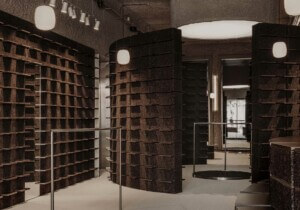In the savanna-like oak forests north of Lisbon, guilds of axe-wielding harvesters swing their machados da cortiça to gently peel off the thick bark of cork oak trees without damaging them. This time-honored tradition preserves an important cultural practice: sustainable management of cork oak forests. Cork was used by ancient Egyptians for sandals and by monks in the Middle Ages for insulation, but today it can be found everywhere from kitchen tools to the aerospace industry.
Bridging this gap between the old and new are companies like Amorim, the largest cork producer in Portugal and the world. Family-owned since 1870, it primarily makes wine stoppers but has expanded into building materials like flooring and insulation. Amorim collaborated with Herzog & de Meuron on the 2012 Serpentine Pavilion and has engaged in cultural programming to generate new knowledge around cork’s potential uses.

In 2013, Amorim began a partnership with Lisbon-based experimentadesign and curator Guta Moura Guedes, inviting designers and architects to experiment with the material. The latest of these investigations is City Cortex, a citywide initiative that activates eight public spaces in Lisbon. The urban interventions ask questions about using cork as an outdoor material. Does cork have a role to play in making our cities softer, safer, quieter, and more hospitable?
We should hope it can. Cork has been used by some of the greatest architects— Frank Lloyd Wright, Marcel Breuer, Eliel Saarinen—to give interiors a touch of warmth and tactility. In addition to its unique material properties, it is a renewable resource that sequesters considerable amounts of carbon—qualities that make it appealing to architects concerned with a sustainable outdoor urban future. Six architects and designers were invited to participate in City Cortex: Eduardo Souto de Moura; Diller Scofidio + Renfro; Leong Leong; Gabriel Calatrava; Stefan Sagmeister; and Yves Béhar.

In recent years, there has been a proliferation of these cultural events—the “biennale”-style exhibition. They’re intended to showcase new knowledge and encourage formal experimentation. Martino Stierli described the phenomenon as “an ever-accelerating expansion of the logic of the event and of the recurring spectacle in architectural discourse and production on an increasingly global scale.” With City Cortex, it is this “eventization” that pulls architecture media out of the gallery, off the screen, and into the city.

In the case of Souto de Moura, he simply wanted to give visitors at the Museum of Art, Architecture and Technology a soft place to sit. He devised a cork chair just for them. Stefan Sagmeister used cork in tiles to communicate a message of positivity on the ceiling of an underground pedestrian walkway. Calatrava designed a pavilion from playscape ground coating made of cork, which was repurposed for benches, a canopy, and chairs coated in the material. The pavilion was donated to the community and will remain indefinitely.

For Amorim, showcasing what cork can do not only fulfills its mission and promotes its product, but also suggests that it’s eager to contribute to the city more broadly. The company is clearly not alone in seeing cork as a national cultural asset.
In our age of mass media overload, the eventization of architectural discourse is only as good as the people who see it online. As the American political strategist James Carville once said, “In this business, you haven’t said anything until you’ve said it on television.” Professor of corporate communication and public affairs Dan Schill, in his book Stagecraft and Statecraft: Advance and Media Events in Political Communication, describes three goals of a successfully staged media event: agenda setting (defining a problem), priming (setting up the background), and framing (curating potential solutions). The installations at City Cortex fulfilled all three by producing and broadcasting images of urban interventions, but also offered a larger message of cork’s potential role in the city.

The works on display were collaborations between Amorim and leading designers. What is next is exciting. Will they do more? Can they push the limits of these teams to produce more intimate research and collaborations? Would this project work in other places? Amorim and experimentadesign have a history of such innovation, and City Cortex could be the start of a new era for cork.
Matt Shaw is a New York–based critic and author of American Modern: Architecture; Community; Columbus, Indiana











